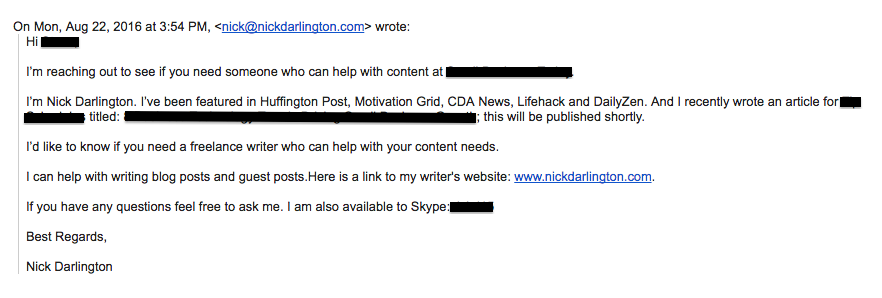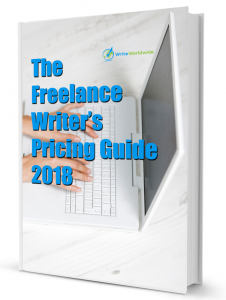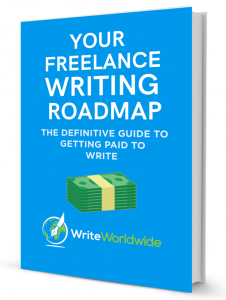$6,250. That’s how much I’ve earned from a single freelance writing gig that I landed only three months after launching my freelance writing business. How did I do it?
The simple answer: cold pitching. But nothing is ever that simple, and the email exchange (which I’ll share with you) confirms this. It was, in fact, ugly. Very, very ugly.
Maybe that’s the experienced writer in me talking? It’s always easy to look back and cringe when you see something your “less experienced self” has done.
Regardless, I’m convinced that the writer I am today would have dealt with the situation better and closed the deal much faster. The responses I gave the client revealed how unsure I was about myself (to me, anyway).
But who could blame me if I lacked confidence? I was new to freelance writing and everything that came with it. From pitching and niching to negotiating rates and closing the deal, I had no clue. I was also scared because this was a writing gig that I was not accustomed to: writing magazine articles.
But you know what? I landed that client, despite being a beginner. Despite my lack of experience. Despite my fears. How? I took action.
I have since written 16 magazine articles, earning $200-$450 per article and my income to date is $6,250 (and counting).
But enough about that and back to why you’re here: to learn how I did it so that you can bag a similar client. In this post, I’ll reveal everything: the exact pitch I sent, why it worked, the email exchange, and the events that resulted in landing the writing gig.
I’ll try to recall the events and my feelings accurately, which may prove difficult as this was a year ago.
Before I proceed, I want to highlight two key points:
Cold Pitching Won’t Work if You’re a Bad Writer
The strategy works best if you can write well. Sure, you may land the odd low-paying gig with poor writing, but that’s not what you want, is it?
If your writing’s bad or you know of someone else’s who is, get hold of our Ultimate Guide on How to Improve Your English Writing Skills.
Cold Pitching is Only One Piece of the Puzzle
A lot happens behind the scenes. Before I was ready to pitch, I positioned myself, built a writer website and updated my social media presence. That was my foundation for freelance writing success.
I also bolstered my social proof by getting featured in a major publication: The Huffington Post. Major publications increase your credibility and allow you to command higher rates. I leveraged that credibility in my pitch.
I also spent hours prospecting for clients. I built up a prospect list and found editors’ email addresses with the help of Google, LinkedIn, and email-finding apps before I was ready to pull the trigger and send my pitch.
The Pitch That Got The Response
It was a simple pitch, one I borrowed from the blogging master, Bamidele Onibalusi. I altered it slightly but kept the core of what makes a solid pitch (I’ll dissect the text later). Here’s what I sent and the prospect’s response:


For those that are on mobile and want to easily “steal” the pitch for their use, here’s the text:
Subject line: Content at (company name)
Hi (insert name),
I’m reaching out to see if you need someone who can help with content at (insert company}.
I’m Nick Darlington. I’ve been featured in (insert publications (s)). And I recently wrote an article for (company name): (insert article titled); this will be published shortly.
I’d like to know if you need a freelance writer who can help with your content needs.
I can help with writing blog posts and guest posts. Here is a link to my writer’s website: www.nickdarlington.com.
If you have any questions feel free to ask me. I am also available to Skype: nickd15
Best Regards,
Nick Darlington
Before I share the email exchange and events that transpired, let’s dissect my original message.
Why The Pitch Works
- The subject line was on the mark. It was concise, not “spammy”, and descriptive enough, while still arousing curiosity.
- I personalised the email. I took the time to find the name of the decision maker. It showed that I was serious about doing business and that I cared. Would you rather read an email directed at you or a generic one that says “Hi” or “Good Day”?
- The purpose of my pitch was instantly clear in the first paragraph: “I’m reaching out to see if you need someone who can help with content”.Keeping the mail on point was the best strategy, especially as he probably receives many emails daily.
- I included social proof to show the prospect that I was a serious writer and could deliver the goods. It put me in a position of power to command higher rates.
- I outlined my services. With a strong subject line, opening sentence, and second paragraph I briefly described my services to show what value I could provide. I also provided a link to my website, where he could get more information. Having a website showed I was a serious business owner, and I didn’t hesitate to share that.
- I encouraged a response. I told the prospect to ask questions if he had any and that we could jump on a Skype call if he wanted.
The pitch has everything to warrant a reply. And the bonus? I had managed to target the prospect at the exact time that he needed a writer.
I had reached out to help with his blog but he responded with other requirements, which caught me off guard: He wanted someone to write profile and cover stories for his magazine.
I had no experience writing magazine articles. Regardless, I continued with what ended up being a lengthy exchange of over 50 emails across different threads. The whole time, I had this thought in the back of my mind: “What am I going to do if I get this writing gig? I have no experience.”
The Email Exchange
I asked if we could jump on a Skype call; he was in the United States, and I was in South Africa.
Hi (name)
Thank you for the prompt reply. Is it possible to arrange a Skype call as I am based in South Africa?
Cheers
Nick
But he made it abundantly clear that he wasn’t a fan of Skype with a concise response: “Sorry. Not a Skype fan.”
I remember thinking: “If he doesn’t want to jump on Skype, what’s the point?” I would have to set up my phone to make international calls (yes, I was on one of those prepaid deals). It seemed like a lot of hassle for something that may not work out.
But that was just an excuse. Secretly, I was fearful about what I was going to do if I landed the gig. How was I going to write it? Would I be able to deliver?
Seeking comfort, I consulted a Facebook writing group for advice. Most people said that I should reach out to him because I had nothing to lose. In hindsight, they were right.
I proceeded, thinking: “What’s the worst that could happen? Get the gig? That wouldn’t be that bad, would it? I mean, I could learn on the job.”
I sent a response, agreeing to my first ever client call. Talk about stepping out of my comfort zone!
I can’t remember the exact details of the call, but I recall him telling me a story about how only recently his entire house had flooded with water. Their vintage car (I think it was a Jaguar) was damaged and, as a result of the chaos, they weren’t able to keep up with their monthly release of the magazine. They were in dire need of a writer. Me, perhaps?
After the call, I thanked him for his time via email and said I would be in contact. I didn’t think anything would come of it. The doubts about my lack of experience still lingered. It was scary.
But two days later, I started a new mailing thread titled “Possible Next Steps”. I sent this email, once again thanking him for the chat and proposing a way for us to move forward:
Hi (name),
Again, thanks for the chat the other day. I have been reading the material in your online editions. Sharing and writing inspiring stories like these resonates with me, as is evident through my blog www.getbutterflied.com. In short, this interests me.
I propose the following and I welcome your suggestions:
Send me through some material and I will put together a short test article, no more than 150 words, to see if I can nail down the style of writing that you are looking for.
I also thought that I would ask you at this point what your budget is. There’s no point in working on a piece if your budget and my rates are out of sync (of course, we can negotiate).
I look forward to your feedback.
Kind Regards
Nick Darlington
I got this response:
Hey Nick!
I haven’t forgotten you.
Your email just got buried with some other urgent business.
I really do not have any “150-word” interviews. Most are 600-700 word stories to 1500 word stories to 3000+ word stories.
What can we do from here?
I would love to have you interview.
We pay between $300-$500 per article (editing included).
Sure, I know it is below where most good writers like yourself are, I could supplement that with an ad in the magazine with an added value of say $1500/month for a half page.
Let me know if you are interested in moving forward or not.
Thanks,
All I read in that email was “Pay between “$300-$500” and “Most good writers like yourself”.My pitch, which included my social proof, had apparently struck a positive chord. It didn’t matter that I was a newbie; they didn’t know that.
With that jolt of confidence, I was certainly interested in moving forward. I enthusiastically sent the following email:
Hi (name),
I understand you don’t have short pieces like that. I was just offering to write a short piece to see if I can nail down the style before we forge ahead. That’s an offer that still stands.
Regarding payment, that sounds fine. Can we agree on $0.12 per word then, together with a half-page ad?
When you say you’d love to have me interview, what you mean?
Yes, yes, I know $0.12 a word is nothing. But as a beginner, it felt right. We all have to start somewhere, right?
I received a short reply where he mentioned that he would have to chat to his wife (who is the editor):
I meant “audition” by writing an article.
We have interviews that need writing, but not 150 words.
I’d rather pay a flat fee plus the ad.
Let me discuss the arrangement with (name).
We then jumped on one last conference call and agreed that I would write a test article, which was due in a couple of days. Things were looking good.
But I was still reluctant to land the gig.
In one last effort of self-sabotage, I emailed the client, asking them for an extension due to an emergency (which didn’t exist). When the client responded saying that they couldn’t extend the deadline I told them I would make a plan. My fate was sealed.
I would have to write the article, and thankfully so. Only a few days after submitting it, I received an email saying they needed my help:
Hey Nick!
Can you please call me sometime today or over the weekend?
I need your assistance with a couple of articles.
I am taking (name) out of the editor’s chair for a little while, until she is out of pain, has her hip replacement surgery and then is “on the mend”.
I need to turn around a few stories asap.
Thanks in advance,
I jumped on that final call, sent a follow-up email asking for their budget, and before I knew it we were finalising the article rate. Here’s that chain of emails:
The Follow-up to the Call:
Hi (name),
Was great chatting.
Just thought I’d send this mail out quick before I sleep.
What is your budget for these two pieces – I’m happy to work on a fixed rate per article.
I invoice via PayPal. Do you have PayPal?
Cheers
His Response:
$200 per?
Usually, it is about $100 per page.
Of course, I am giving you a 1/2 page (horizontal) ad in (publication).
I have attached our rate card with the mechanical requirements for same on the last page.
Please let me know.
Thanks,
My Response:
Hi (name),
$200 per article works, together with the ad. You happy with PayPal?
Cheers,
They agreed to pay via PayPal, and I wrote my first ever magazine article with absolutely no prior experience. I learned on the job and delivered what the client wanted by matching their publication’s style (yes, that involved reading and re-reading content on their site).
The first article was a hit: he agreed to increase my rate to $300, and I haven’t looked back.
I have since written 16 magazine articles for them, including cover stories for $450, and have earned $6,250.
Beyond the monetary value of the deal, I’ve refined my writing skills by ruthlessly editing my work and hiring an editor. Shout out to Spike Wyatt.
The quality of my writing has increased tenfold in a year. And to think that I nearly didn’t land that gig because of my fears? Crazy.
Conclusion
Cold pitching. That’s the technique I used to land my most lucrative client yet. On paper it’s simple: send a beautifully crafted email, and you’ll land that client. The reality is that it’s never easy, and it’s even harder when you’re a beginner who’s fighting fears of inadequacy.
But if you’re someone who writes well, lays the foundation and builds credibility through guest posting, it’s only a matter of time before one of your pitches hits the mark, and you get a positive response.
The only things stopping you now are your fears. As you take small steps, such as jumping on your first client call and deciding how to negotiate your way through a deal, you’ll slowly overcome those fears. Before you know it, you’ll wonder why you were ever afraid.
P.S. If you want access to other pitches that will help you bag high-paying clients, grab our Pitching Template Cheat Sheet.




Great post! One thing that usually fascinates me about Nick is being meticulous in each and every post. You always disseminate information to upcoming writers with so much clarity. I am glad to learn from you from time to time.
FEAR, no doubt, is (F)ake (E)vidence (A)ppearing (R)eal. So, many talents have been buried and remained buried because of fear.
Thanks Nick, you’ve always nailed it each time.
Hi Bamidele,
Thanks for the kind words. My goal is always to write simply so that others understand. I think the fact that I’m still a new writer (only been writing for just over a year) helps because I’m talking from experience. It’s fresh in my mind. I can relate to beginner writers.
And I make it a point to share step-by-step how I did something. Does it take longer? Sometimes, yes, particularly with adding all those extra screen shots and making it perfect. But it’s worth it at the end. And it’s comments like these that confirm I’m on the right track and give me the encouragement to keep doing what I’m doing.
Thanks again Bamidele. May your writing career go from strength-to-strength.
P.S. And I agree talents do remain buried because of fears. And for what?
Cheers,
Nick
Awesome article Nick. I’ve been using cold pitching to get my clients. I mostly use Bamidele’s strategies, with a few tweaks of my own.
One thing I’ve always had cold feet about is making/receiving client calls. My main worry is about accents. Like, will I understand what the client says? Will he get my accent?
We all come from different backgrounds and more often than not, different countries (continents). So I worry maybe the client will not get my accent and will assume I’m not capable of resonating with the audience in written communication.
How do you handle such fears, Nick? On my part, I have declined so many calls and at times it costs me the client but I want to change this and have more verbal conversations with however feels a call is necessary.
Hi Felix,
Thanks for the comment. Bamidele’s cold pitching emails are great. I use those too with a few tweaks of my own. Works like a charm 🙂
Now in terms of your fear about jumping on a call. Firstly, yes I am a native English speaker, but I technically have an accent (South African English). Secondly jumping on calls isn’t my favourite thing either, but like taxes, it needs to be done. It’s part and parcel of running a successful freelance writing business, and it’s just something you need to overcome.
If you couldn’t string a sentence together in English, then yes, I’d also be scared to jump on a call. But I’m assuming you can based on how well-written the above is. I think you should also ask yourself the following: Is your accent as bad as you think it is? Will my client actually care? Does it really matter? People all over the world have accents (as I mentioned, myself included). Ultimately you only overcome that fear by just jumping on a call. I guarantee it won’t be as bad as you think.
Would you like to start with me? I’m available, just drop me a note:) nick (at) nickdarlington.com and we can arrange a Skype call.
P.S. Here is a great article on Fast Company titled “How to Turn Your Accent into a Public-Speaking Asset“.
Cheers,
Nick
I love the honesty in this article. We can all relate to the inclination to ‘self-sabotage’ but we seldom recognise it and rarely admit to it. Your article hits the mark because you are unafraid to take responsibility for the challenges you faced/created. With your ability to self-reflect, regroup and adapt, you writing career has no limits. Thank-you for sharing and for inspiring others.
Hi Jody,
Thanks for the kind words 🙂
Cheers,
Nick
great work Nick…thanks for the clarity
Hi Daphine,
No problem. It’s only a pleasure.
Cheers,
Nick
Hi Nick,
Your success is an overwhelming one. I love this zeal you went into this thing and within a short while you’ve set a record many couldn’t set in a long while.
More interestingly, I love that spirit of Bamidele that runs in all of us, and that’s to share, share and never hold back.
Keep it up. Obviously, $6k is not N6k (Nigerian currency)… Lol. This is a huge amount in Nigeria. Most Bank workers don’t earn that in a year.
Never stop.
Hi Emenike,
Thanks for your comment. Yes, I’ve just gone for it. It’s funny how your confidence just grows and grows and grows. You feel unstoppable.
Like Bamidele, I have always believed in giving and giving and giving some more. That’s why I think I’ve connected with him so well.
Ya, I am aware of how fortunate I am to be in the position where I am earning what I’m earning. There are many others who struggle to make ends meet. So, I’m grateful.
Cheers,
Nick
Hello Nick,
This really is an interesting article. Cold-pitching definitely works if you can find someone to send such an email. How do you find the right potential client to send a cold-pitch?
Hi Christine,
Thanks. Finding the right clients starts with knowing what you want to write about. If you have a niche simply Google companies and publications in that niche and use LinkedIn to find them.
Similarly, if you can’t pin down a niche, select several and search for those. For example, when I started I wasn’t sure on a niche, and I simply googled keywords like “technology companies”.
Once you visit those companie’s/publication’s sites you can assess whether they need your services. Ask yourself questions like, “Do they have a blog”. Chances are if they have a blog, they believe in content marketing and it’s an easy sell.
I also wrote about a unique approach to finding clients, by targeting writers in your niche and then seeing who they write for. Read the article “How to Land Freelance Writing Jobs Online, Fast“.
Another article that might help is a recent post by Ciaran titled “How to Build a Killer Prospect List and Generate Your Own Freelance Work Opportunities“.
If you have any more questions, ask away and/or reach out directly at hello at writeworldwide.com or nick at writeworldwide.com.
Cheers,
Nick
Wow what an inspiration.
I was about to throw in the towel but now am rejuvenated.
I will keep on fighting to land a well paying gig.
Thanks pal.
Hi Benedict,
Thank you for your comment. Don’t throw in the towel. Keep pitching and experimenting with other techniques to land clients. Our article titled “5 Powerful Ways to Land High-Paying Clients“, details some of those techniques.
LinkedIn is another great tool that our very own Richard Rowlands uses to successfully find clients. Read his article “How to Find Freelance Writing Clients on LinkedIn (A System That Works)“.
Ultimately, it’s up to you and the work you put in. Keep at it. If you have any questions, don’t hesitate to get in contact 🙂 We are here to help.
Cheers,
Nick
Hi Nick,
Your article sounds to me like what I would write about myself, save for the fact that you are already on the move. Fear and self-sabotage are real. In fact, they are bigger than anyone can imagine in terms of their effect on would-be writers.
It is sad that I am yet to shake the feeling of inadequacy off. As Ojo Bamidele rightly observes above, my talent is one of those that still remain buried despite taking a training course from Walter Akolo close to 2 years ago.
Lately, I have read several inspiring posts like yours. They have jolted me back to reality and hopefully, I will be sharing a similar story not so long into the future.
Thanks for helping me kick my confidence up a notch higher. Keep soaring.
Cheers!!
Hi George,
Thanks for your comment.
The only thing that will help you overcome any fear and get results is ACTION. Take one small step each day like drafting an email to someone, researching how to do something, buying a domain, building a website, pitching one publication and so on. Over time these steps add up and before you know it you’re flying at a million miles an hour. Go for it!
Cheers,
Nick
Hi Nick,
Glad I came across your article. What George has written up there is exactly my predicament. Fear and the feeling of insufficiency is very real. Have read loads of article from established writers but there is always an excuse. Did a training with Mr. Walter Akolo but took no action.
I do not have a website and so I wonder what I will show as proof. Kindly give your thoughts on this.
This article has stirred the writing in me and I am going to take action asap.
Thank you for the inspiration.
Jemmimah
Hi Jemmimah,
Thanks for your comment 🙂
I’ll go back to your comment, “but took no action”. That’s the real problem here. No one is going to do the work for you. Build your business from the ground up, starting with your website. Get featured in a major publication and start prospecting and pitching for clients. I wrote a detailed post on how I built a freelance writing business and earned $2793 last month. It’s a guest post on FreelancerKenya’s website.
Additionally visit our Start Here page. There’s a section that will help you become a freelance writer. I’d also suggest the ‘Earn Your First $1000 as a Freelance Writer” page on Writers in Charge.
You can do it. But you just need to take action and do the work. If you have any more questions, don’t hesitate to reach out.
P.S. We’re in the process of creating an eBook detailing how to build your writing business and land high-paying clients. In it, we will share actionable strategies, screen shots, and case studies to help kickstart your writing career. But don’t wait for that, there’s no reason why you can’t make progress daily, no matter how small it is.
Keep at it!
Cheers,
Thanks Nick. Will come back with a testimony
God Bless
You’re welcome 🙂 Please do.
Am still having cold feet. But after this read, and many of my fears are summed up here, I think I will get with it.
Hi Tess,
Thanks for commenting. Yes, the only way you overcome these fears is by taking action.
Cheers,
Nick
Kudos Nick for the highly informative post.I’m profoundly refreshed after learning that keeping pulses with your practically laid-out strategies is indeed fruitful.Keep up the selfless gesture of reaching back for beginners!
Hi Peter,
Thanks for your comment. I’m happy you found the post valuable.
Cheers,
Nick
That was very helpful and inspiring, Nick. Thank you for taking the time to write this piece!
Hi Vilma,
Thank you 🙂 There’s plenty more in the pipeline.
Cheers,
Nick
Thanks, Nick! Just what I needed to hear.
The only thing that’s stopping me is my fear (and it’s all thanks to the voices in my head and not something that has happened)
Hi Wangui,
Thanks for your comment. I believe that those voices never totally disappear and we just need to keep tabs on them. I also believe that taking action is the best way to displace any fears you may have. With each small step, you take you develop more confidence and courage!
Cheers,
Write your experience on how you wrote those feature articles(cover stories and profiles). Did you interview people for this? I am afraid of interviewing people because I am not a native English speaker. I can write, but not fluent in verbal communication. Do you have any advice? I am really frustrated on this.
Hi Sayed,
Thank you for your email. My client did the interview and I hired a transcriber.
As for how I wrote those first few – well I formed an outline from the transcription, read their previous issues, and basically nailed down their style. The more I practiced this, the better I got. The entire writing process is a lot faster now.
As for improving your verbal communication, all I can suggest is speaking the language more. Find someone online that you can converse with and practice. A quick Google search will also help you with that as there are plenty of apps and online platforms you can also use. Are there any English tutors where you stay?
Feel free to reach out directly if you have any more questions.
Cheers,
Nick